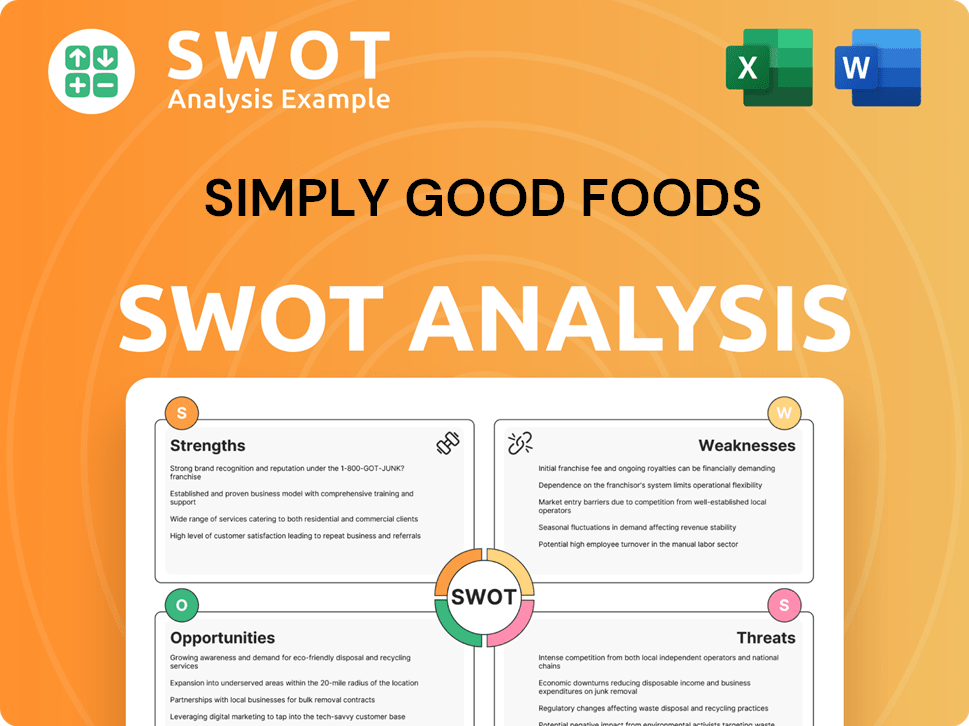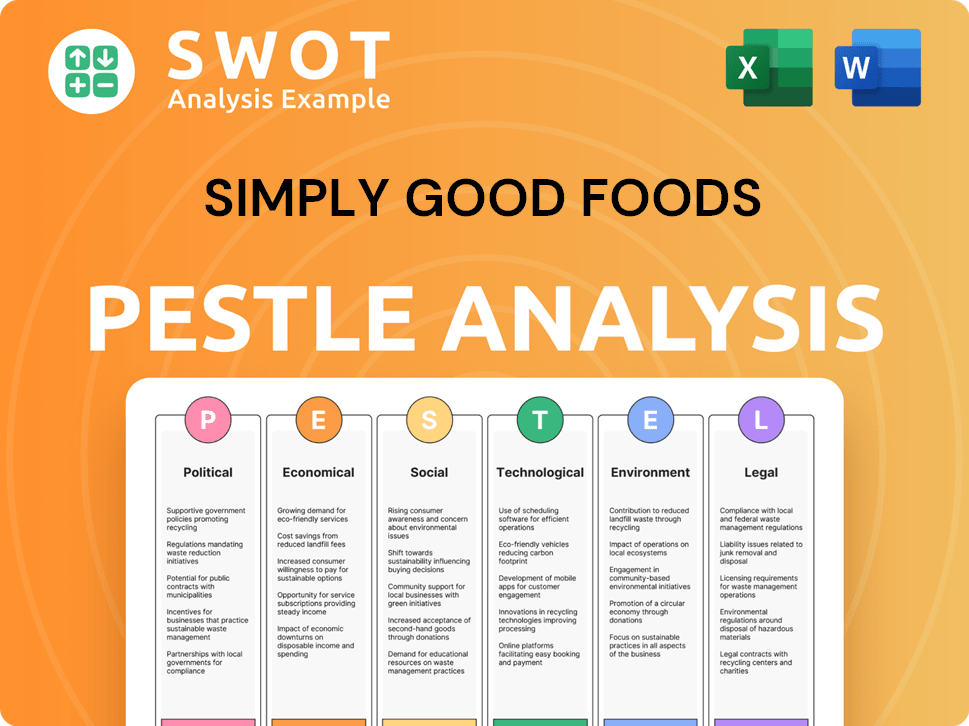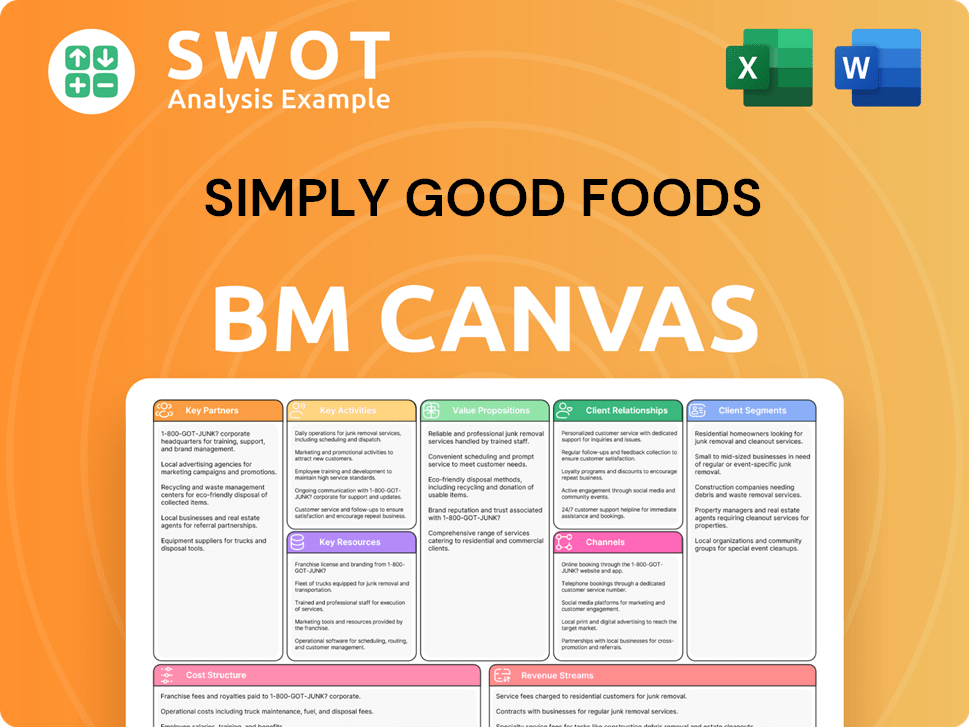Simply Good Foods Bundle
How Does Simply Good Foods Conquer the Snack Market?
The Simply Good Foods Company, a leader in the nutritional snacking arena, has masterfully navigated the competitive landscape through strategic sales and marketing maneuvers, especially after acquiring Quest Nutrition. This strategic pivot from its initial focus on the Atkins brand, known for its low-carb approach since 1989, has been instrumental in its expansion. This Simply Good Foods SWOT Analysis will help you understand the company's position.

This analysis dives deep into the Sales strategy and Marketing strategy of Simply Good Foods, examining its evolution from a niche player to a diversified snacking powerhouse. We'll explore the Company overview, its innovative Business model, and how it strategically positions its Product portfolio to capture market share. Understanding the Simply Good Foods sales performance analysis and the impact of its Marketing campaigns of Simply Good Foods is key to grasping its success.
How Does Simply Good Foods Reach Its Customers?
The sales channels of Simply Good Foods, a company focused on nutritional snacking, are designed to maximize reach through an omnichannel approach. This strategy includes both online and offline methods to ensure its products are accessible to a wide consumer base. The company's approach to sales and marketing strategy is comprehensive, focusing on both traditional and digital channels.
Simply Good Foods leverages a variety of channels to distribute its products. These include brick-and-mortar retail, e-commerce platforms, and specialized retail outlets. This diversified approach is crucial for reaching different consumer segments and capitalizing on various purchasing behaviors. The company's sales strategy aims to maintain a strong presence across multiple platforms.
The company's sales strategy is built around a multi-channel approach, ensuring its products are widely available. This strategy includes a mix of traditional retail, e-commerce, and specialized outlets. The goal is to ensure products are accessible wherever consumers choose to shop, which is a key aspect of their marketing strategy.
Simply Good Foods products are prominently featured in major grocery stores, mass merchandise retailers, and club stores across North America. This includes retailers such as Walmart, Target, Kroger, and Costco. This extensive retail presence is vital for driving impulse purchases and ensuring broad consumer access to the products. This is a key part of their distribution strategy.
E-commerce plays a crucial role in Simply Good Foods' sales strategy, with products sold through the company's brand websites (Atkins.com and QuestNutrition.com) and major online retailers like Amazon. This direct-to-consumer (DTC) approach allows for greater control over brand messaging and customer data. The digital presence is essential for catering to the increasing trend of online grocery shopping.
Simply Good Foods partners with wholesale distributors to ensure efficient product delivery and penetration into various retail segments. These partnerships are vital for optimizing product placement and inventory management. The company's focus remains on driving consistent growth and maintaining market share in the competitive nutritional snacking industry through these distribution channels.
While the company doesn't rely on direct sales teams for individual consumers, dedicated sales and account management teams manage relationships with retail partners and distributors. These teams focus on promotional activities and optimizing product placement. This approach ensures effective execution across all sales channels.
The company's sales strategy has evolved to meet changing consumer behaviors, focusing on digital adoption and omnichannel integration. The company's sales performance analysis shows a continued emphasis on expanding its digital capabilities to drive online sales. For a deeper dive into the financial aspects, consider exploring the Revenue Streams & Business Model of Simply Good Foods.
Simply Good Foods' sales channels are designed to maximize reach and cater to evolving consumer preferences. The company's approach includes a mix of traditional retail, e-commerce, and wholesale distribution. This multi-channel strategy supports the company's overall business model.
- Brick-and-Mortar Retail: Products are available in leading grocery stores, mass merchandise retailers, and club stores.
- E-commerce: Direct-to-consumer sales through brand websites and major online retailers.
- Wholesale Distribution: Partnerships to ensure efficient product delivery and retail penetration.
- Sales and Account Management: Dedicated teams manage relationships with retail partners and distributors.
Simply Good Foods SWOT Analysis
- Complete SWOT Breakdown
- Fully Customizable
- Editable in Excel & Word
- Professional Formatting
- Investor-Ready Format

What Marketing Tactics Does Simply Good Foods Use?
The marketing tactics employed by Simply Good Foods are multifaceted, designed to build brand awareness, generate leads, and drive sales for its Atkins and Quest brands. Their approach blends digital and traditional media, leveraging a variety of strategies to reach their target audience effectively. This includes a strong emphasis on content marketing, search engine optimization, and paid advertising across various digital platforms.
Digital marketing forms a cornerstone of their strategy, with content marketing playing a significant role in establishing thought leadership and engaging consumers. They also utilize influencer partnerships and social media platforms for brand building and direct consumer communication. Traditional media, such as TV advertising, is still used, especially for broader brand awareness campaigns, showing a balanced approach to reach different segments of their target market.
Data-driven marketing is a key component, with customer segmentation and personalization efforts to create more effective campaigns. While specific technology platforms aren't publicly detailed, it's reasonable to assume they use analytics tools to track performance and optimize marketing spend. The marketing mix has clearly pivoted towards digital-first strategies, reflecting changing consumer habits.
Simply Good Foods heavily invests in digital marketing. This includes content marketing, SEO, and paid advertising on Google and social media.
Influencer collaborations are a significant part of their strategy. They partner with fitness, health, and lifestyle influencers to promote their products.
Social media platforms are crucial for brand building and direct consumer interaction. They use these platforms to engage with their audience.
TV advertising is still utilized for broader brand awareness. This ensures that they reach a wider audience.
They use customer segmentation and personalization for more effective campaigns. This data-driven approach helps optimize their marketing spend.
Email marketing is used to nurture leads and promote new products. This helps in customer retention and driving sales.
The company's marketing strategy is designed to support its target market. The shift towards digital-first strategies reflects the changing media consumption habits of its target audience. The use of interactive digital content and highly visual social media campaigns resonates with health-conscious consumers. The company's focus on data-driven marketing, customer segmentation, and personalization efforts allows for more effective and targeted campaigns. While specific financial details for 2024 and 2025 are not available, the company's continued investment in digital marketing and influencer collaborations indicates a commitment to adapting to the evolving consumer landscape and maintaining a strong brand presence.
Simply Good Foods employs a multifaceted marketing strategy to reach its target audience effectively. Their approach blends digital and traditional media to build brand awareness, generate leads, and drive sales.
- Digital Marketing: Utilizes content marketing, SEO, paid advertising on Google and social media platforms (Facebook, Instagram, TikTok), and email marketing.
- Influencer Partnerships: Collaborates with fitness enthusiasts, health coaches, and lifestyle influencers.
- Social Media Engagement: Leverages social media for brand building, community interaction, and direct consumer communication.
- Traditional Media: Employs TV advertising for broader brand awareness campaigns.
- Data-Driven Approach: Employs customer segmentation and personalization for more effective campaigns.
Simply Good Foods PESTLE Analysis
- Covers All 6 PESTLE Categories
- No Research Needed – Save Hours of Work
- Built by Experts, Trusted by Consultants
- Instant Download, Ready to Use
- 100% Editable, Fully Customizable

How Is Simply Good Foods Positioned in the Market?
The brand positioning of Simply Good Foods centers on distinct strategies for its Atkins and Quest brands within the nutritional snacking market. The company leverages its product portfolio to cater to specific consumer segments. This approach emphasizes 'better-for-you' options, aiming to capture a significant share in the competitive landscape.
Atkins is positioned around weight management and healthy living, focusing on sustained energy and controlled carbohydrate intake. Quest Nutrition targets active lifestyles and fitness enthusiasts, emphasizing high protein, low sugar, and indulgent taste. Both brands aim to differentiate themselves through product innovation, taste, and nutritional profiles, addressing consumer demand for snacks that balance health and flavor. This dual-brand strategy allows Simply Good Foods to broaden its reach within the nutritional snacking market.
Simply Good Foods maintains brand consistency across all channels, from product packaging to digital content and advertising. The company actively monitors consumer sentiment and competitive threats, adapting its brand messaging and product offerings to remain relevant. This strategic approach supports the company's sales strategy and overall business model.
Atkins is positioned for weight management and healthy living. It emphasizes sustained energy and controlled carbohydrate intake. The visual identity often uses clean aesthetics to convey health and vitality.
Quest Nutrition targets active lifestyles and fitness enthusiasts. It focuses on high protein, low sugar, and indulgent taste. The visual identity is dynamic to resonate with a younger demographic.
Both brands share a core message of providing 'better-for-you' options. They aim to offer health benefits without compromising on taste. This approach is key to their marketing strategy.
Atkins targets individuals following low-carb or ketogenic lifestyles. Quest Nutrition appeals to those who prioritize protein intake and clean ingredients. Understanding the Simply Good Foods target market is crucial.
Simply Good Foods maintains brand consistency across all channels. The company actively monitors consumer sentiment and competitive threats. This allows for adaptation in messaging and product offerings.
- Consistent messaging across product packaging, digital content, and advertising.
- Continuous monitoring of consumer feedback and market trends.
- Adaptation of brand messaging and product offerings to stay competitive.
- Focus on innovation to meet evolving consumer preferences.
The company's focus on brand positioning is critical for its Growth Strategy of Simply Good Foods. In 2024, Simply Good Foods reported net sales of approximately $1.1 billion, demonstrating the effectiveness of its sales strategy and marketing strategy. The company's ability to adapt to the dynamic nutritional snacking landscape is crucial for maintaining and growing its market share. The company's success is also reflected in its investor relations and its ability to manage its marketing budget effectively.
Simply Good Foods Business Model Canvas
- Complete 9-Block Business Model Canvas
- Effortlessly Communicate Your Business Strategy
- Investor-Ready BMC Format
- 100% Editable and Customizable
- Clear and Structured Layout

What Are Simply Good Foods’s Most Notable Campaigns?
The sales and marketing strategies of Simply Good Foods are crucial to its success, driving brand awareness and consumer engagement. The company has implemented several key campaigns that have significantly impacted its product portfolio and market share. These campaigns often leverage digital marketing and influencer collaborations to reach target demographics effectively.
Simply Good Foods focuses on integrated campaigns that promote both its brands, capitalizing on the trend toward healthier eating. These initiatives highlight the convenience and taste of their products, aiming to increase household penetration and repeat purchases. The company's ongoing investment in digital advertising and influencer marketing remains a cornerstone of its strategy, allowing for targeted reach and measurable results.
For a deeper understanding of the company's origins and journey, you can explore the Brief History of Simply Good Foods.
The 'New Atkins' campaign broadened the diet's appeal beyond strict carb counting. This involved TV commercials, digital advertising, and collaborations with health influencers. The goal was to rejuvenate the brand and attract new consumers, boosting brand relevance and sales. This approach has been instrumental in the company's sales strategy.
Quest Nutrition's 'cheat clean' messaging highlights that consumers can enjoy products without compromising their nutritional goals. This strategy is particularly effective on social media platforms like Instagram and TikTok. The campaigns feature visually appealing product shots and testimonials, driving engagement and brand visibility within the fitness community.
Simply Good Foods focuses on integrated campaigns to promote both brands under the umbrella of 'better-for-you' snacking. These campaigns emphasize the convenience and taste of their products. The company continues to invest in digital advertising and influencer marketing for targeted reach and measurable sales lift. This reflects the company's comprehensive marketing strategy.
Digital advertising and influencer marketing are key components of Simply Good Foods' marketing strategy. These initiatives are designed to reach specific consumer segments and measure campaign effectiveness. This approach is crucial for driving sales growth strategies and enhancing brand positioning.
Simply Good Foods leverages diverse marketing campaigns to boost its product portfolio. The company focuses on digital marketing initiatives and influencer marketing to enhance consumer engagement. These strategies are designed to improve the company's market share and overall sales performance.
- 'New Atkins' Approach: Reintroduced the brand with a focus on flexibility and modern dietary needs.
- 'Cheat Clean' Messaging: Emphasized enjoyment without compromising nutritional goals, particularly on social media.
- Integrated 'Better-For-You' Campaigns: Promoted both brands, highlighting convenience and taste.
- Digital and Influencer Marketing: Utilized for targeted reach and measurable results.
Simply Good Foods Porter's Five Forces Analysis
- Covers All 5 Competitive Forces in Detail
- Structured for Consultants, Students, and Founders
- 100% Editable in Microsoft Word & Excel
- Instant Digital Download – Use Immediately
- Compatible with Mac & PC – Fully Unlocked

Related Blogs
- What are Mission Vision & Core Values of Simply Good Foods Company?
- What is Competitive Landscape of Simply Good Foods Company?
- What is Growth Strategy and Future Prospects of Simply Good Foods Company?
- How Does Simply Good Foods Company Work?
- What is Brief History of Simply Good Foods Company?
- Who Owns Simply Good Foods Company?
- What is Customer Demographics and Target Market of Simply Good Foods Company?
Disclaimer
All information, articles, and product details provided on this website are for general informational and educational purposes only. We do not claim any ownership over, nor do we intend to infringe upon, any trademarks, copyrights, logos, brand names, or other intellectual property mentioned or depicted on this site. Such intellectual property remains the property of its respective owners, and any references here are made solely for identification or informational purposes, without implying any affiliation, endorsement, or partnership.
We make no representations or warranties, express or implied, regarding the accuracy, completeness, or suitability of any content or products presented. Nothing on this website should be construed as legal, tax, investment, financial, medical, or other professional advice. In addition, no part of this site—including articles or product references—constitutes a solicitation, recommendation, endorsement, advertisement, or offer to buy or sell any securities, franchises, or other financial instruments, particularly in jurisdictions where such activity would be unlawful.
All content is of a general nature and may not address the specific circumstances of any individual or entity. It is not a substitute for professional advice or services. Any actions you take based on the information provided here are strictly at your own risk. You accept full responsibility for any decisions or outcomes arising from your use of this website and agree to release us from any liability in connection with your use of, or reliance upon, the content or products found herein.